Modern Analytics & Reporting with Milvus Vector DB and GenAI

As technology advances, the role of AI systems is expanding, with multiple stakeholders relying on these systems for insights and decision-making while actively interacting with them. This growing complexity has made modern analytics and reporting tools essential for understanding and evaluating AI systems’ performance. During the recent Unstructured Data Meetup in August in New York City, Bill Reynolds from Qarbine—a company specializing in modern data collaboration - discussed how the integration of Milvus with Qarbine and Generative AI (GenAI) can transform the way unstructured data is analyzed, offering excellent efficiency and insight.
 Bill Reynolds from Qarbine speaking at the NYC August Unstructured Data Meetup
Bill Reynolds from Qarbine speaking at the NYC August Unstructured Data Meetup
In this blog, let’s understand the role of vector databases such as Milvus, how Qarbine simplifies the analytics process, and how Milvus and Qarbine can be integrated to create advanced GenAI applications.
Let’s dive right into it.
Understanding Milvus: Leading Vector Database by Zilliz
What are Vector Databases?
Traditional databases were used to store structured data, and similarity searches were performed using exact query matches. This approach was inefficient as it could not handle unstructured or high dimensional data and couldn’t perform semantically efficient query searches.
Vector databases are designed to store, manage, and query high-dimensional data represented as vectors. Vectors are numeric representations of data, such as text, images, or audio. These vectors capture the characteristics of the data in a way that makes similar items have nearby vector representations. Therefore, vector databases efficiently store unstructured data and perform semantically meaningful query searches.
Key Features of Milvus
- Scalability: Milvus supports large-scale vector data management. Its ability to handle millions or even billions of vectors makes it suitable for applications like image search, recommendation systems, and content-based retrieval.
- Real-time Processing: Milvus can retrieve vectors in real time, allowing for dynamic applications like personalized product recommendations and AI-driven analytics.
High-performance Search: Milvus uses Approximate Nearest Neighbor (ANN) search algorithms, optimized for fast and accurate retrieval of relevant vectors based on similarity. This feature is crucial for handling real-time analytics and AI workflows.
Multimodal Support: Milvus works across a variety of data types - text, images, video, and more. By converting these data types into vectors, Milvus enables seamless multimodal data integration.
- Bring Your Own LLM (Large Language Model): The flexibility of integrating both public and private large language models (LLMs) into Milvus-powered applications allows organizations to implement customized search and recommendation systems based on their specific needs.
Qarbine: Enhancing Analytics and Reporting
Modern Application Challenges
In the talk, Bill Reynolds highlights the modern application challenges faced by various stakeholders while accessing the same AI application.
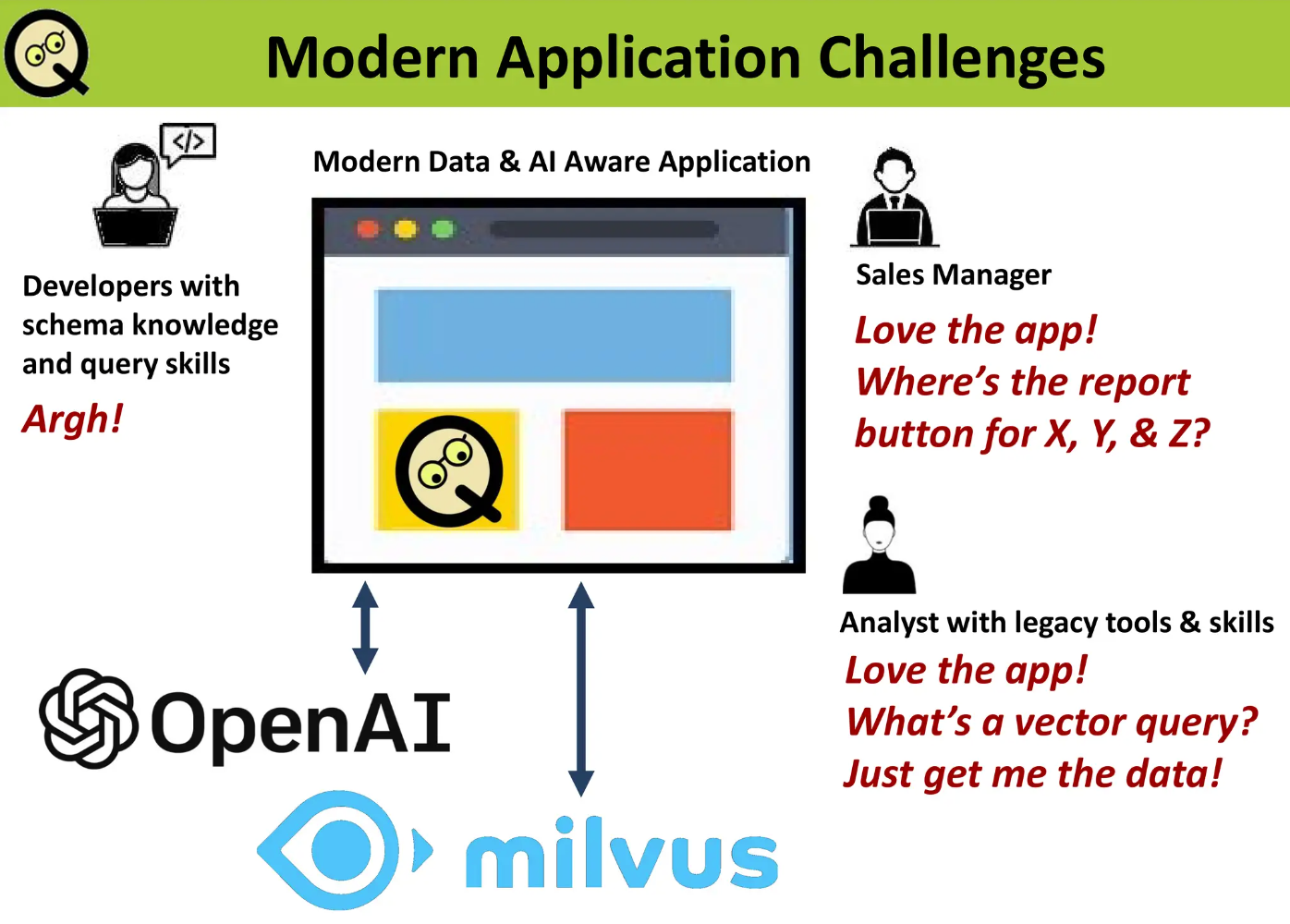
As shown in the image, many applications are not friendly for various stakeholders simultaneously. For example, developers have schema and query skills expertise, and sales managers look for report and analysis options. In contrast, analysts with knowledge of legacy tools and skills are interested in data and may not understand technical terms such as vector query. As a result, Qarbine fills this missing gap by providing a range of helpful tools for developers and analysts, along with accessible visualizations and analytics reports.
Key Features of Qarbine

While Milvus provides the database infrastructure, Qarbine simplifies the analytics and reporting process. Qarbine acts as a bridge between developers and analysts, ensuring that even non-technical users can leverage Milvus’s vector search capabilities without deep knowledge of data science or database queries.
Simplified Data Queries
Qarbine abstracts the complexities of Milvus’ vector search algorithms, offering an easy-to-use interface. For example, Qarbine users can write SQL-like queries to interact with the database, allowing them to perform searches, run reports, and generate insights without needing to dive into the intricacies of vector operations.
Customizable Reporting
In addition to query simplification, Qarbine offers customizable reporting tools. With integration into business intelligence (BI) platforms, Qarbine enables users to visualize and analyze data from Milvus in real time. Analysts can create dynamic reports and dashboards, extracting valuable insights from unstructured data while ensuring the scalability and performance of Milvus.
Qarbine Application Architecture with Milvus
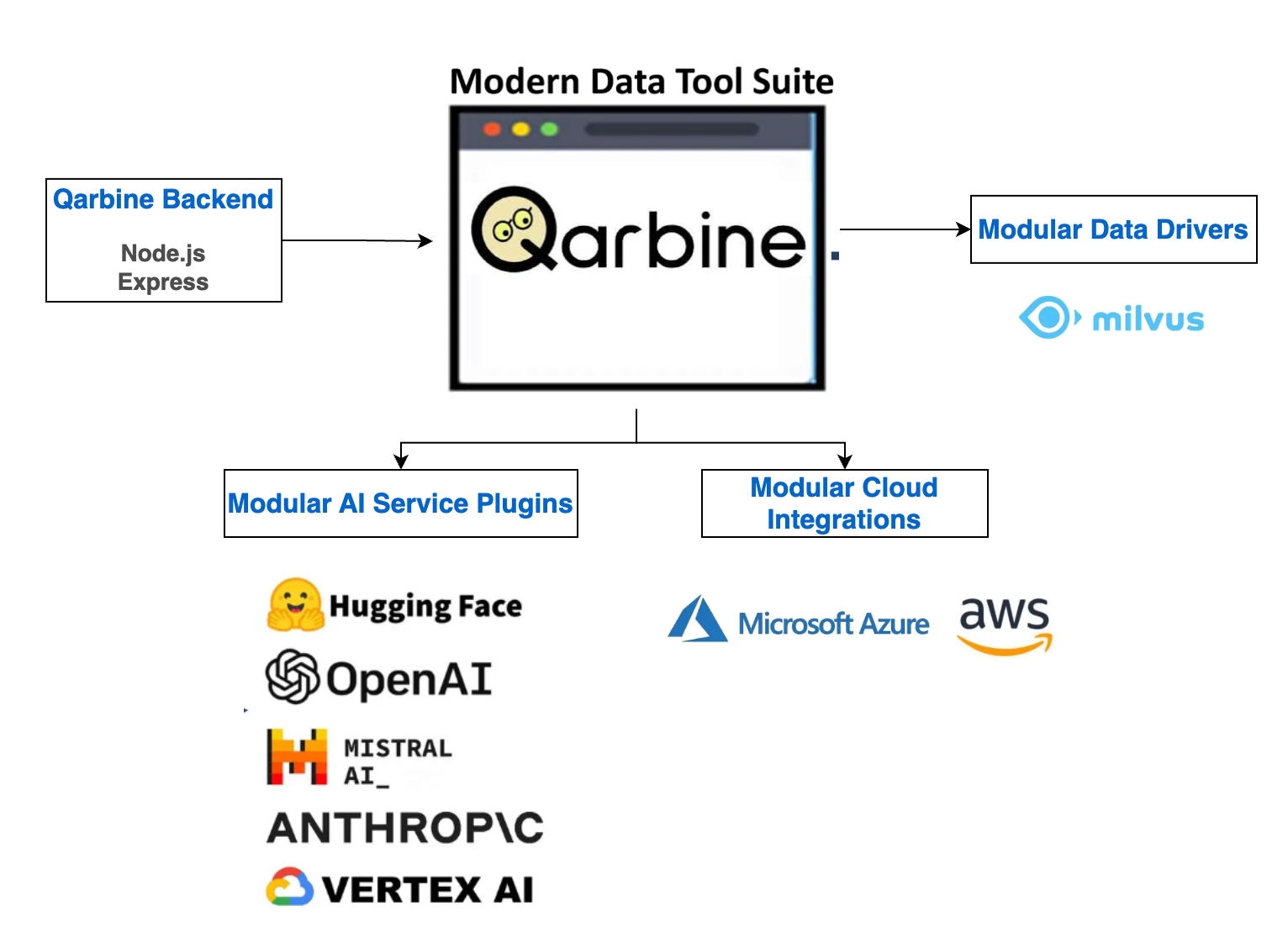
Qarbine is a user-facing tool that acts as a platform for data analytics and collaboration where multiple stakeholders, like developers, analysts, etc., can interact. Its backend comprises Node.js and Express. It provides modular service plugins that integrate with various external AI and cloud platforms such as Microsoft Azure, AWS, Hugging Face, OpenAI, Mistral AI, and so on. This modularity allows it to be flexible and scalable to adapt to different technologies or services. Additionally, Qarbine also offers modular data drivers that can be used to connect with a database such as Milvus. These integrations with Qarbine allow analysis and report generation for various AI tasks.
Simplified Node.js Queries with Qarbine
Basic Milvus Retrieval Query
var milvusClient = new MilvusClient(options:ClientConfig)
milvusClient.query({
collection_name: COLLECTION_NAME,
filter: ‘id>0’,
output_fields: [‘vector’, ‘id’],
})
Basic Milvus Vector Retrieval Query
milvusClient.search({
vector: [ … ],
collection_name: COLLECTION_NAME,
output_fields: [‘*’],
expr: “color in [‘pink_8682’, ‘red_9392’]”,
limit:5,
})
Advancing GenAI Applications with Milvus and Qarbine
Overall Execution Flow from Vector Database to Fetching Analysis Results
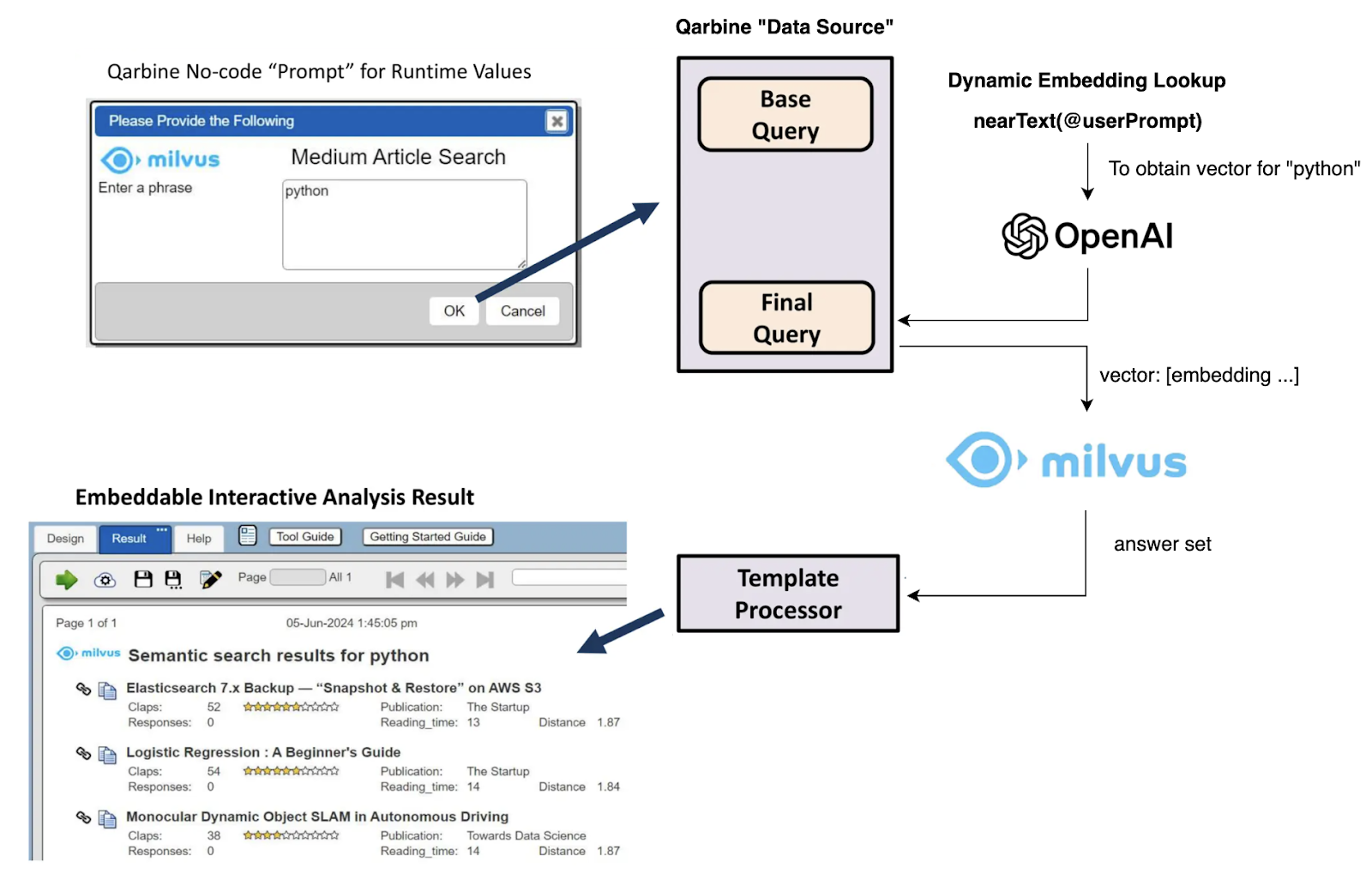
Overall Execution Flow for Fetching Analysis Results with Qarbine, OpenAI, and Milvus
Dynamic RAG Analysis
What is Retrieval Augmented Generation (RAG)?
RAG (Retrieval-Augmented Generation) is an approach in natural language processing (NLP) that combines retrieval-based and generation-based methods to enhance the capabilities of language models. The goal is to improve the accuracy, relevance, and factuality of generated text by leveraging external data sources. It works on two key concepts -
Retrieval-Based Methods:
- These methods focus on retrieving relevant information from a large corpus or knowledge base. When a query is made, the system searches for documents or data that are most relevant to the query and retrieves them.
Generation-Based Methods:
- Generation-based methods involve generating text from scratch based on the input. Models like GPT or other transformer-based models use pre-learned knowledge to generate coherent and contextually relevant responses.
How does RAG work?
When a question or input is presented to the model, the retriever searches through a knowledge base for the most relevant documents. The generator then uses the retrieved content as input context to generate the final answer, ensuring that the information is relevant.
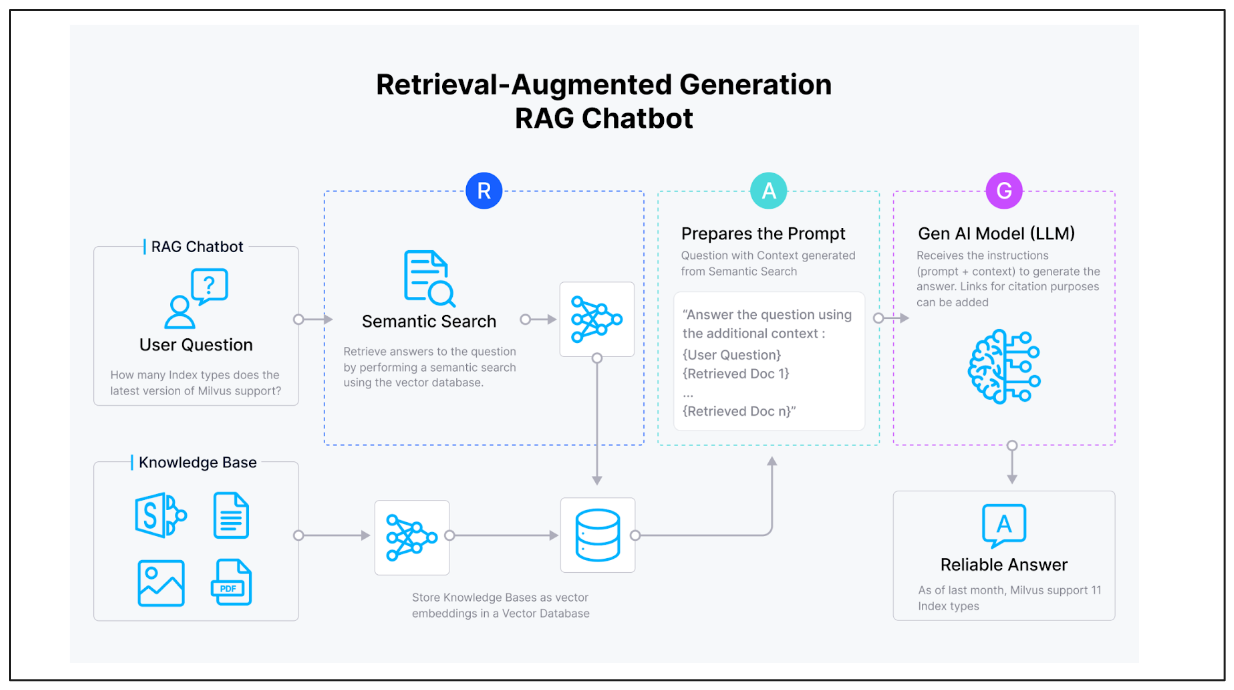 Working of RAG
Working of RAG
How can RAG be implemented with Milvus and Qarbine?
The integration of Milvus and Qarbine can pave ways for using GenAI approaches such as RAG. Analysts can use Qarbine to enter their prompts which will then be passed to Milvus to obtain contextually relevant results. This can be used in a RAG setting wherein the retrieved data is used to generate the final answer. Here, Milvus, with its fast and efficient operations, serves as an ideal database for storing and retrieving embeddings. Qarbine, with its advanced analytics, is able to generate meaningful reports or visualizations for faster insights and more dynamic decision making.
These integrations are very useful for applications such as chatbots, virtual assistants, and question-answering systems.
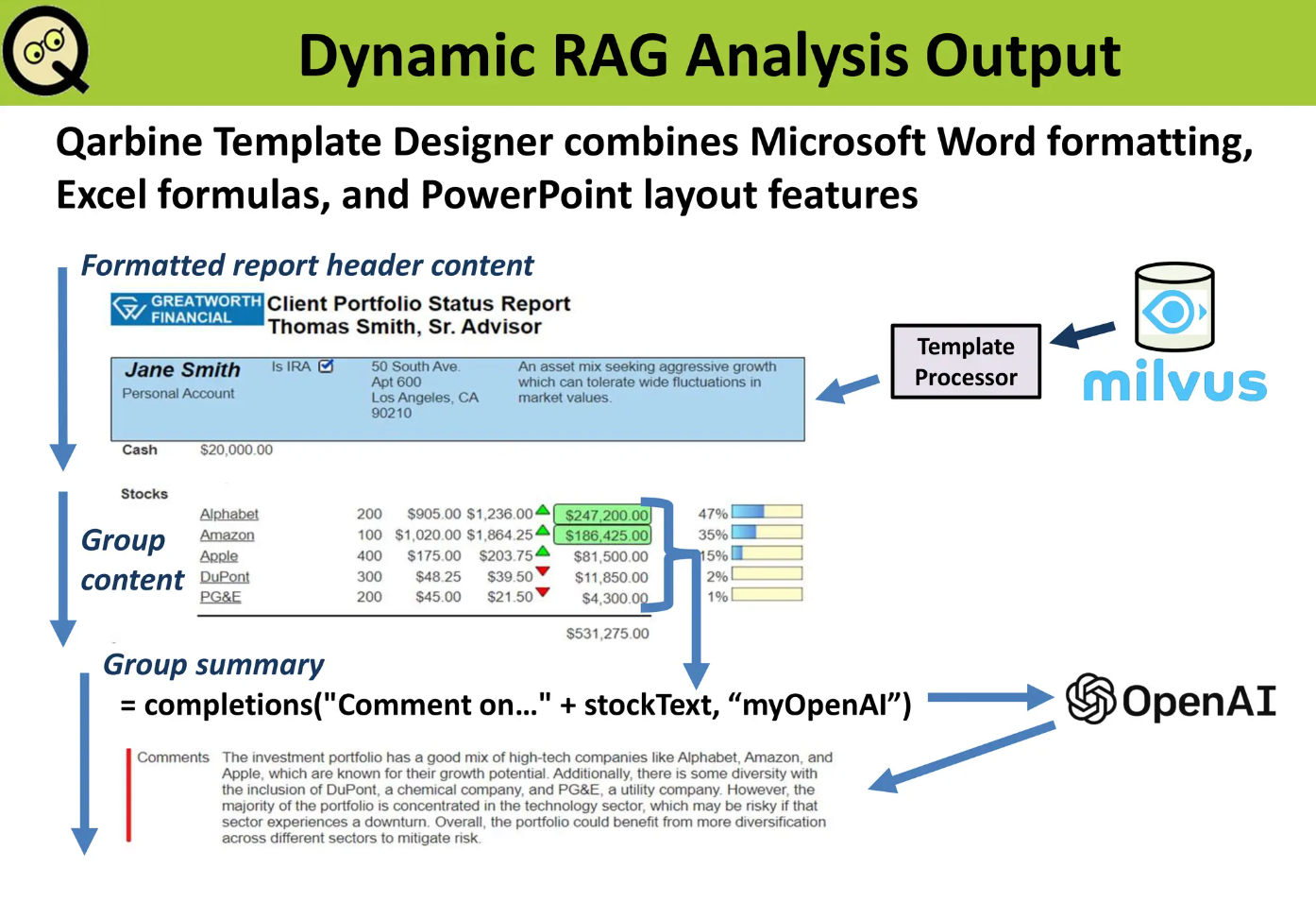 Example output of dynamic RAG analysis with Milvus and Qarbine
Example output of dynamic RAG analysis with Milvus and Qarbine
Interactive RAG with AI Assistant
With Qarbine, it is also possible to create a simple Interactive RAG application with its “Ask AI” assistant. When clicked on “Ask AI” in Qarbine’s interface, it will open up a prompt box wherein you can type your question and mention which AI model should do the job.
For example, consider a real world chatbot scenario. The chatbot can query Milvus for past customer interactions, pulling in vector embeddings that reflect previous conversations. Using this data, the chatbot can respond in a personalized, human-like manner, improving the overall user experience.
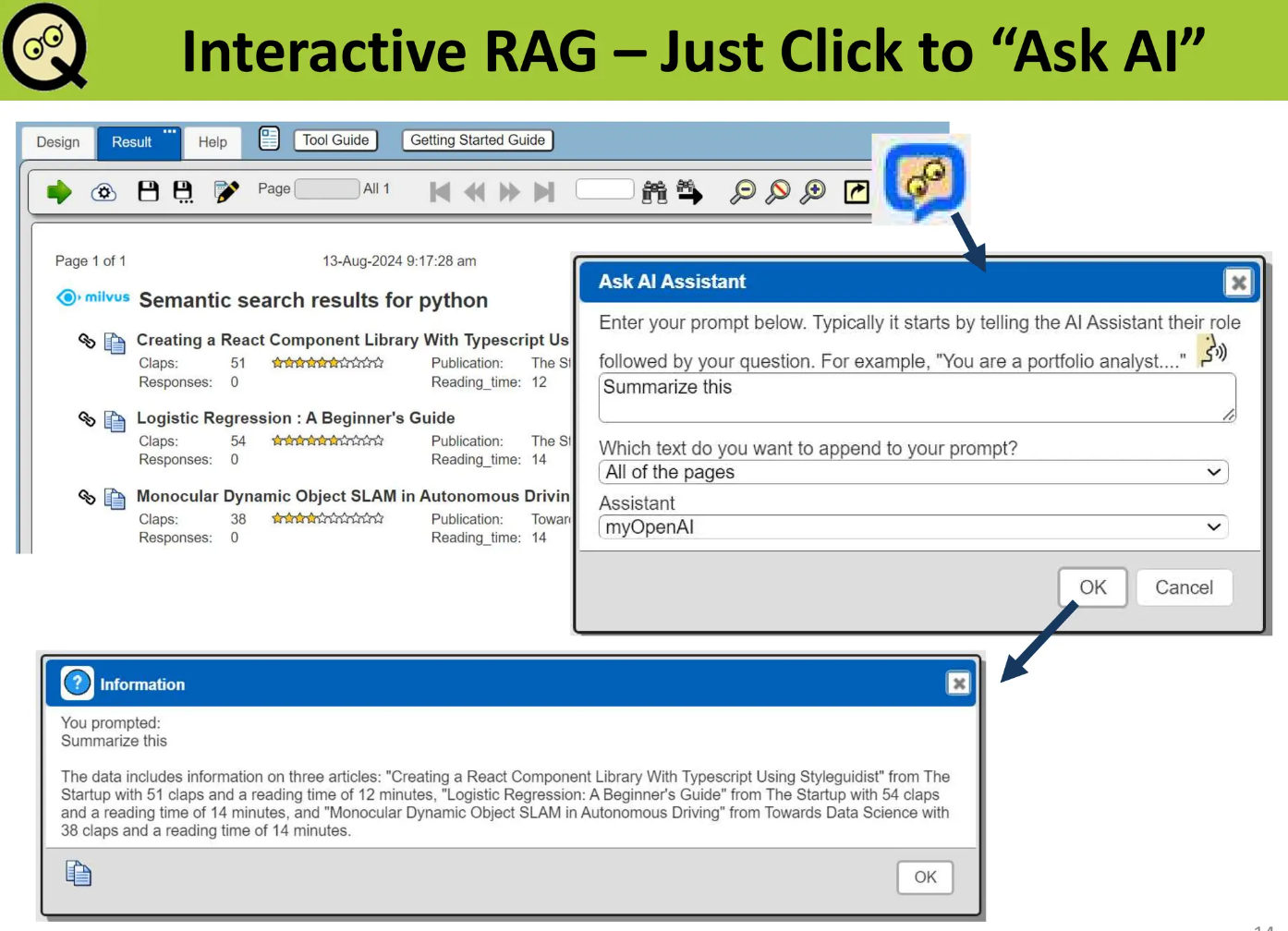 Interactive RAG with Milvus and Qarbine
Interactive RAG with Milvus and Qarbine
Other Real World Use Cases of Milvus and Qarbine
The integration of Milvus and Qarbine can have real-world applications in various industries. Let’s explore some of them.
E-commerce Product Recommendations
Milvus can store vector embeddings representing products, user interactions, and reviews. Using these vectors, the system can deliver personalized product recommendations in real time. Qarbine’s interface allows business analysts to adjust the recommendation algorithms without needing to understand the vector database, streamlining operations.
Healthcare Predictive Modeling
Milvus can store complex medical data such as MRI scans, genomic data, and patient records as vectors. This data can then be analyzed by AI models to predict cardiovascular risk, disease progression, or even recommend personalized treatment plans. The Qarbine interface ensures that medical professionals can access and interpret this data in a meaningful way.
Media Content Recommendation
In the media industry, Milvus can store large amounts of video and image embeddings. By querying these embeddings, platforms can offer content recommendations based on user preferences. Qarbine allows non-technical staff to create and modify these recommendation queries without having to go through the engineering team.
Conclusion
The integration of Milvus and Qarbine presents a great application for organizations to manage and derive insights from unstructured data. Milvus, with its high-performance vector search capabilities, and Qarbine, which simplifies the analytics and reporting process, form a platform for building advanced GenAI applications. This collaboration enhances efficiency and grants stakeholders across various departments access to harness the power of AI without needing deep technical knowledge. This combination can be useful for industries such as e-commerce, healthcare, and media, providing real-time, actionable insights and fostering dynamic decision-making processes.
- Understanding Milvus: Leading Vector Database by Zilliz
- Qarbine: Enhancing Analytics and Reporting
- Advancing GenAI Applications with Milvus and Qarbine
- Conclusion
Content
Start Free, Scale Easily
Try the fully-managed vector database built for your GenAI applications.
Try Zilliz Cloud for FreeKeep Reading

Migrating from S3 Vectors to Zilliz Cloud: Unlocking the Power of Tiered Storage
Learn how Zilliz Cloud bridges cost and performance with tiered storage and enterprise-grade features, and how to migrate data from AWS S3 Vectors to Zilliz Cloud.

Zilliz Cloud Delivers Better Performance and Lower Costs with Arm Neoverse-based AWS Graviton
Zilliz Cloud adopts Arm-based AWS Graviton3 CPUs to cut costs, speed up AI vector search, and power billion-scale RAG and semantic search workloads.

What is the K-Nearest Neighbors (KNN) Algorithm in Machine Learning?
KNN is a supervised machine learning technique and algorithm for classification and regression. This post is the ultimate guide to KNN.